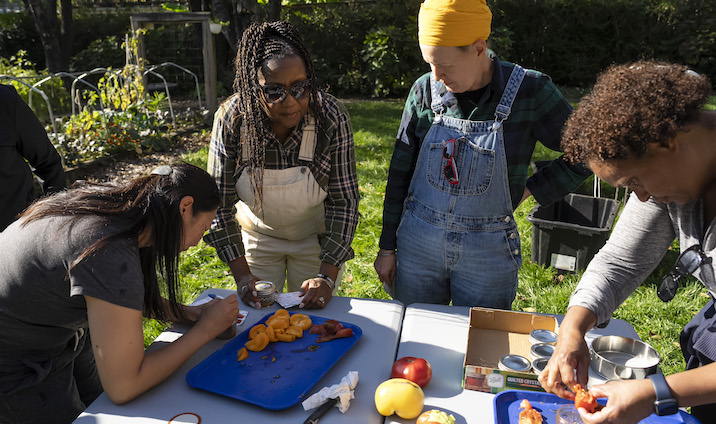Urban Agriculture | October 27, 2022
How Anyone Can Grow Food in the City
 Growing food in a community garden is a great option, but with enough sunlight and planning, it's also possible to grow your own food at home. Photo credit: Ben Hider
Growing food in a community garden is a great option, but with enough sunlight and planning, it's also possible to grow your own food at home. Photo credit: Ben Hider The height of the 2022 food growing season has come and gone, but it’s never too early to start thinking ahead to next year. Fall and winter allow plenty of time to plan to grow your own food in any capacity, whether that’s a personal tomato plant at home or in a community garden.
Our Urban Agriculture team has expert advice for food production in all city environments and for gardeners of all skill levels. We caught up with our Deputy Director of Urban Agriculture Corey Blant to learn some at-home food gardening basics for beginners. Additionally, if you’re looking for more technical advice, we invite you to check out our Gardener’s Guide that has useful information for absolute beginners and seasoned growers alike. And want to branch out of your own space? Check out our map of community gardens to find one near you.
In what ways can tending an edible garden in the city be accessible, even if you are restricted in terms of space or location?
Corey Blant: The two most important factors to consider when starting any garden in a city are space and light. Once you have those, you’re pretty much good to go! The other essentials like containers, plants, soil, and water are relatively easy to secure. I know plenty of people in the city—my partner Beth included!—who find a way to grow a wide variety of edible plants even with just a few square feet of space. Both indoors and outdoors are fair game, too, assuming there’s enough light.
Can someone create garden spaces indoors or on fire escapes? If so, what are some main things they should keep in mind? Are there any plants that grow particularly well in these environments?
CB: Indoors, definitely! Again, just keep space and light in mind. You may have to get grow lights and there are lots of great resources online for which are best for certain plants.
Fire escape gardens seem like a lovely spot to grow food, but that’s technically illegal here in New York since they could get in a firefighter’s way. Window boxes are perfectly legal though and can actually add more growing space to a small apartment.
Perennial herbs are an easy gateway plant for container gardening. It’s pretty straightforward to start with some mint, rosemary, oregano, lemon balm, lavender, or chives. Plant them once and they’ll return the following year!
If you’ve got tomatoes in mind for next year, don’t worry about getting heirloom varieties. Aim for something more robust like a beefsteak, which is more likely to do well in a wider range of conditions. You’ll also need a trellising plan and you should consider a more nitrogen-heavy organic fertilizer. If anything I’m saying is a new concept for you, you can read more about it in NYRP’s very own Gardener’s Guide.
View this post on Instagram
What tools or materials would you recommend for people who want to start their own city garden?
CB: In addition to space and light like I mentioned, a container, water, and soil are essential.
Almost anything can be a planter—it really just depends on your space. If you’ve got the room with enough light, 5-gallon buckets are great for nightshades like tomatoes, eggplants, and peppers. Window boxes can be great options for growing herbs, for example. Depending on what you want to grow, assess how big it will get at maturity and work backwards for container size from there. Whatever you choose, though, be sure it can drain!
In terms of water, figure out your plan. My partner Beth, who tended a rooftop container garden we once had, used to fill up old seltzer bottles and carry them with her. If you’re able to connect a hose to a faucet, great! Otherwise a watering can is just fine, too.
I’m not a soil snob. Depending on what you want to grow, an expert at any garden center should be able to help you decide what’s best. I would recommend finding a local soil source like McEnroe Organic Farm here in New York if you’re able. Adding some local compost like what GrowNYC, the Lower East Side Ecology Center, and East New York Farms distribute here is a good idea for nutrients and soil structure, too.
Tools at this scale are pretty simple. You could probably get by with just your hands. A trowel is always useful, and again, consider what might need a trellis. Our NYRP Gardener’s Guide has a good breakdown of tools you might consider based on what you’re growing, but I’d say pricey gadgets should be one of the least of your concerns when starting to garden.
For updates on NYRP gardening workshops and other learning opportunities, subscribe to our email alerts and follow us on social media.